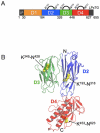Supramolecular organization of the repetitive backbone unit of the Streptococcus pneumoniae pilus
- PMID: 20559564
- PMCID: PMC2886109
- DOI: 10.1371/journal.pone.0010919
Supramolecular organization of the repetitive backbone unit of the Streptococcus pneumoniae pilus
Abstract
Streptococcus pneumoniae, like many other Gram-positive bacteria, assembles long filamentous pili on their surface through which they adhere to host cells. Pneumococcal pili are formed by a backbone, consisting of the repetition of the major component RrgB, and two accessory proteins (RrgA and RrgC). Here we reconstruct by transmission electron microscopy and single particle image reconstruction method the three dimensional arrangement of two neighbouring RrgB molecules, which represent the minimal repetitive structural domain of the native pilus. The crystal structure of the D2-D4 domains of RrgB was solved at 1.6 A resolution. Rigid-body fitting of the X-ray coordinates into the electron density map enabled us to define the arrangement of the backbone subunits into the S. pneumoniae native pilus. The quantitative fitting provide evidence that the pneumococcal pilus consists uniquely of RrgB monomers assembled in a head-to-tail organization. The presence of short intra-subunit linker regions connecting neighbouring domains provides the molecular basis for the intrinsic pilus flexibility.
Conflict of interest statement
Figures






References
-
- Källström H, Islam M, Berggren PO, Jonsson AB. Cell signaling by the type IV pili of pathogenic Neisseria. Biol Chem. 1998;273:21777–21782. - PubMed
-
- Telford JL, Barocchi MA, Margarit I, Rappuoli R, Grandi G. Pili in Gram-positive pathogens. 2006;4:509–519. - PubMed
-
- Elena SF, Whittam TS, Winkworth CL, Riley MA, Lenski RE. Genomic divergence of Escherichia coli strains: evidence for horizontal transfer and variation in mutation rates. Int Microbiol. 2005;8:271–278. - PubMed
-
- Mattick JS. Type IV pili and twitching motility. Annu Rev Microbiol. 2002;56:289–314. - PubMed
Publication types
MeSH terms
Substances
Associated data
- Actions
- Actions
- Actions
- Actions
LinkOut - more resources
Full Text Sources
Other Literature Sources

